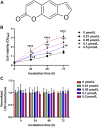Psoralen Promotes Proliferation, Migration, and Invasion of Human Extravillous Trophoblast Derived HTR-8/Svneo Cells in vitro by NF-κB Pathway
- PMID: 35462898
- PMCID: PMC9024043
- DOI: 10.3389/fphar.2022.804400
Psoralen Promotes Proliferation, Migration, and Invasion of Human Extravillous Trophoblast Derived HTR-8/Svneo Cells in vitro by NF-κB Pathway
Abstract
Recurrent spontaneous abortion (RSA) is a kind of pathological pregnancy, and abnormal function of trophoblast cells may be related to a variety of pregnancy complications including RSA. Psoralen is an effective ingredient extracted from Cullen corylifolium (L.) Medik. with multiple bioactivities mainly including anti-osteoporotic, anti-tumor, anti-inflammatory, and estrogen-like effects. However, the exact role of psoralen on trophoblast invasiveness has not been investigated thus far. In the present study, the effects of psoralen on the proliferation, migration, and invasion abilities of HTR-8/SVneo cells were evaluated by the CCK-8 and Transwell assays. The expression patterns of nuclear factor κB (NF-κB)/p65 and metalloproteinases (MMP)-2 and MMP-9 were characterized by further experiments including real-time quantitative polymerase chain reaction and Western blot. Indirect immunofluorescence was applied to track the NF-κB p65 translocation. Herein, we found that cell viability and invasive ability were promoted by psoralen in a concentration-dependent manner. Psoralen concentration-dependently enhanced both MMP-2 and MMP-9 expression and their activity of HTR-8/SVneo cells. Additionally, we observed accelerated nuclear accumulation and enhanced nuclear translocation of p65 in the presence of psoralen. Furthermore, invasiveness enhancement of psoralen on HTR-8/SVneo cells was partly eliminated by a NF-κB pathway inhibitor. Thus, our findings suggest that psoralen may serve as a potential repurpose drug candidate that can be used to induce migration and invasion of trophoblast cells through strengthening the NF-κB pathway.
Keywords: NF-κB pathway; human extravillous trophoblast; invasion; migration; proliferation; psoralen.
Copyright © 2022 Qi, Lu, Fu, Lv and Hou.
Conflict of interest statement
The authors declare that the research was conducted in the absence of any commercial or financial relationships that could be construed as a potential conflict of interest.
Figures





Similar articles
-
Sodium dichloroacetate improves migration ability by suppressing LPS-induced inflammation in HTR-8/SVneo cells via the TLR4/NF-κB pathway.Iran J Basic Med Sci. 2024;27(1):16-23. doi: 10.22038/IJBMS.2023.68252.14902. Iran J Basic Med Sci. 2024. PMID: 38164486 Free PMC article.
-
The Increased lncRNA MIR503HG in Preeclampsia Modulated Trophoblast Cell Proliferation, Invasion, and Migration via Regulating Matrix Metalloproteinases and NF-κB Signaling.Dis Markers. 2019 Jul 30;2019:4976845. doi: 10.1155/2019/4976845. eCollection 2019. Dis Markers. 2019. PMID: 31467616 Free PMC article.
-
[Effect and mechanism of TNF-α and etanercept on the invasion ability of extravillous trophoblast cell in URSA patients].Zhonghua Fu Chan Ke Za Zhi. 2021 Oct 25;56(10):705-711. doi: 10.3760/cma.j.cn112141-20210610-00315. Zhonghua Fu Chan Ke Za Zhi. 2021. PMID: 34823320 Chinese.
-
Baicalein Enhances Migration and Invasion of Extravillous Trophoblasts via Activation of the NF-κB Pathway.Med Sci Monit. 2018 May 8;24:2983-2991. doi: 10.12659/MSM.909722. Med Sci Monit. 2018. PMID: 29735973 Free PMC article.
-
Hyperin promotes proliferation, migration, and invasion of HTR-8/SVneo trophoblast cells via activation of JAK1/STAT3 pathway in recurrent spontaneous abortions.Heliyon. 2023 Jan 13;9(1):e12958. doi: 10.1016/j.heliyon.2023.e12958. eCollection 2023 Jan. Heliyon. 2023. PMID: 36747955 Free PMC article.
Cited by
-
Identification of chromosomal abnormalities in miscarriages by CNV-Seq.Mol Cytogenet. 2024 Feb 18;17(1):4. doi: 10.1186/s13039-024-00671-7. Mol Cytogenet. 2024. PMID: 38369498 Free PMC article.
-
Omega-3 fatty acid supplements and recurrent miscarriage: A perspective on potential mechanisms and clinical evidence.Food Sci Nutr. 2023 Jun 1;11(8):4460-4471. doi: 10.1002/fsn3.3464. eCollection 2023 Aug. Food Sci Nutr. 2023. PMID: 37576058 Free PMC article. Review.
-
Sodium dichloroacetate improves migration ability by suppressing LPS-induced inflammation in HTR-8/SVneo cells via the TLR4/NF-κB pathway.Iran J Basic Med Sci. 2024;27(1):16-23. doi: 10.22038/IJBMS.2023.68252.14902. Iran J Basic Med Sci. 2024. PMID: 38164486 Free PMC article.
-
Cellular Functions of High-Temperature Requirement Factor A4 in Placenta.Cells. 2023 May 24;12(11):1459. doi: 10.3390/cells12111459. Cells. 2023. PMID: 37296580 Free PMC article.
-
New molecular mechanisms of quercetin in improving recurrent spontaneous abortion based on in-depth network pharmacology and molecular docking.Front Chem. 2024 Sep 4;12:1407667. doi: 10.3389/fchem.2024.1407667. eCollection 2024. Front Chem. 2024. PMID: 39296365 Free PMC article.
References
-
- Brouillet S., Murthi P., Hoffmann P., Salomon A., Sergent F., De Mazancourt P., et al. (2013). EG-VEGF Controls Placental Growth and Survival in Normal and Pathological Pregnancies: Case of Fetal Growth Restriction (FGR). Cell Mol. Life Sci. 70, 511–525. 10.1007/s00018-012-1141-z - DOI - PMC - PubMed
LinkOut - more resources
Full Text Sources
Miscellaneous

